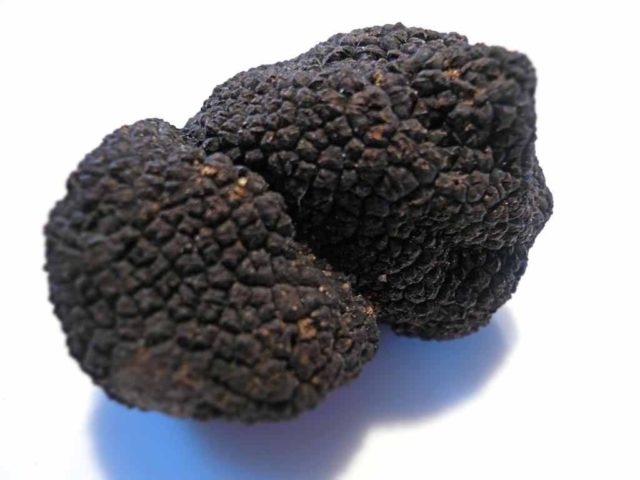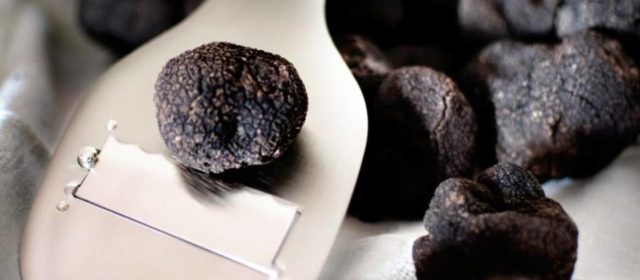Content
Himalayan truffle is a mushroom from the Truffle genus, belonging to the Truffle family. Also known as winter black truffle, but this is just a variety. The Latin name is Tuber himalayensis.
What does a Himalayan truffle look like?
The fruit body does not exceed 2 cm in diameter, and its weight ranges from 5 to 50 g. The surface is hard and the flesh is dense.
The taste of this variety is mediocre, and the aroma is rich, but quickly disappears. Young specimens are odorless and tasteless.
The consistency is fleshy, gristly. In section, the fabric resembles marble, consisting of dark and light veins. These are the external and internal veins of the fruiting body. The color of the pulp is dark purple, almost black.
Where does the Himalayan truffle grow?
Prefers regions with mild climates. The Himalayan variety got its name from the place of growth. This species grows in Tibet, forming a symbiosis with the Himalayan pine and oak. The fruit body is located under the earth at a depth of about 30 cm.
Is it possible to eat the Himalayan truffle
This species is classified as conditionally edible, therefore it is used as food after preliminary processing. The small size of the fruiting body makes it difficult to find it, which is why this species is not in great demand among mushroom pickers.
False doubles
The Himalayan subspecies can be confused with the black French.
This mushroom has an irregular tuberous shape, reaching 3-9 cm in diameter. Grows underground. In young specimens, the surface is reddish brown, in old specimens it is coal-black. At the point of pressure, the color changes, becoming rusty. There are small irregularities on the surface, creating 4 to 6 edges. The aroma is strong, the taste is pleasant, with a bitter tinge.
Black French truffle is a delicacy that is called “black diamond”. It is edible, used as food after pretreatment, raw can be used as a flavoring seasoning.
The main difference from the Himalayan is the large size of the fruit body.
Himalayan truffles are often exported to European countries, passing them off as winter black ones.
Collection rules and use
Fruiting bodies are located underground at a distance of 20 to 50 cm. It is impossible to find them on your own. The French and Italians use specially trained animals to search. Dogs and pigs have a good sense of smell, allowing you to find various species underground.
Puppies are allowed to sniff truffles, pets are selected that react to the smell of mushrooms. Then they are fed with milk with a mushroom supplement. Therefore, animals that have been trained are very expensive.
Pigs in the wild feed on earthen mushrooms, so they are able to find them underground. These animals do not need any special training.
The second method that mushroom pickers use is to hunt flies. It has been observed that stud flies lay their eggs in the ground where the truffles grow. Fly larvae feed on mushrooms. You can find fruit bodies by midges swarming in the foliage.
Benefits and harm to the body
Truffle is a dietary product. There are only 24 kcal per 100 g of mushrooms. The composition includes vitamins and useful microelements: C, B1, B2, PP, potassium, calcium, iron, sodium, copper.
Mushrooms have a positive effect on human health:
- accelerate the recovery of damaged tissues;
- prevent the development of malignant tumors in the intestine;
- delay the aging process of the skin;
- have an antioxidant effect on the body;
- restore the intestinal microflora.
Eating mushrooms is not recommended for women during the period of bearing and feeding a child. It is also undesirable for children under the age of 10-12 to introduce mushroom dishes into the diet.
In all other cases, Himalayan truffle can be consumed with health benefits. The only contraindication may be individual intolerance to the product.
The Himalayan truffle can be used as an addition to a sauce or a flavorful condiment, grated and added to the main course. The special aroma of truffles is fully revealed during contact with other products. The taste is reminiscent of roasted seeds or nuts.
Conclusion
The Himalayan truffle is a representative of the mushroom kingdom that grows underground. Due to seasonality and small size, it is not very popular. It is often passed off as a more expensive specimen - a black French truffle.










